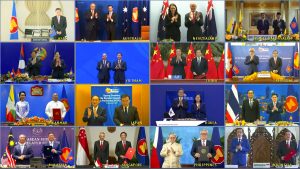By Eleanor Albert

Earlier this week, 15 countries signed a free trade agreement, the Regional Comprehensive Economic Partnership (RCEP), at the 2020 ASEAN Summit virtually hosted by Vietnam. The deal, set to come into force within two years, brings together the 10 ASEAN member states – Brunei, Cambodia, Indonesia, Laos, Malaysia, Myanmar, the Philippines, Singapore, Thailand, and Vietnam – with major trading partners Australia, China, Japan, New Zealand, and South Korea. The trade bloc’s members account for around 30 percent of the world’s population and 30 percent of the world’s GDP.
The deal has been years in the making. Negotiations for RCEP first kicked off during the 2012 ASEAN Summit in Cambodia. As an Asian regional trade pact, some of RCEP’s membership overlaps with that the Comprehensive and Progressive Agreement for Trans-Pacific Partnership (CPTPP, previously TPP), with two notable exceptions: China is not part of the TPP, and the United States, which spearheaded the original TPP, is not part of RCEP. The membership rosters, along with the simultaneous and parallel negotiations between RCEP and TPP, fueled the sense that the two trade pacts were manifestations of competition between the United States and China in Asia – two influential actors in the region and the top two economies in the world vying to set trade rules for years to come.
And while the CPTPP moved ahead after the withdrawal of the United States under the Trump administration’s withdrawal in 2017, RCEP too was concluded without one of its originally intended partners. India pulled out of negotiations in November 2019. The absence of the United States and India from these two multilateral Asian pacts may have consequences beyond trade. As Peter A. Petri and Michael G. Plummer wrote in a June 2020 PIIE report, “even more important than economic gains, however, may be the effects of East Asia’s regional turn on China’s prospects for leadership in the region. The CPTPP and RCEP15 agreements, without the United States and India, remove powerful balancing influences in determining economic policies in East Asia.”
Although China does stand to become a major beneficiary of the trade agreement, it should be emphasized that RCEP was not a China-led initiative. Many analysts have sought to excise this idea as it conflates China’s economic might with its regional leadership and overlooks the role played by ASEAN. For example, the Center for Strategic and International Studies’ Greg Poling noted on Twitter that “RCEP is ASEAN-led, not ‘China-led’ (otherwise Japan wouldn’t be in it). And it isn’t China’s plan for regional economic dominance. BRI is.” Separately, Petri and Plummer called the pact a “a triumph of ASEAN’s middle-power diplomacy.” “The value of a large, East Asian trade agreement has long been recognized, but neither China nor Japan, the region’s largest economies, were politically acceptable as architects for the project. […] Without such ‘ASEAN centrality,’ RCEP might never have been launched,” they add.
In fact, from the beginning the very nature of RCEP was linked to ASEAN centrality. The original 16 RCEP countries, including India, were the 10 ASEAN member states and the six countries which with ASEAN had pre-existing free trade agreements.
Despite the critical role ASEAN has played in ushering RCEP forward, China has not shied away from painting the trade pact as a victory for China and for Asia. Chinese Foreign Ministry Spokesperson Zhao Lijian described the deal’s conclusion as “an important milestone of regional economic integration,” adding that it represented a path for regional economic recovery and growth in the face of the coronavirus pandemic. The Chinese official line was echoed in the media, which heralded the pact as a “landmark achievement” and “milestone” for East Asian cooperation. Numerous Chinese news reports also claimed the signing of RCEP as a win for “multilateralism over unilateralism and free trade over protectionism.” Such references to unilateralism and protectionism are not so subtle jibes at the United States’ trade policies and turn away from multilateralism in recent years.
Comparatively, China doubled down on its participation and support for RCEP, highlighting that it sees itself as committed to greater economic openness and trade liberalization, as well as upholding the value of international cooperation. Chinese news stories also sought to showcase praise of RCEP from neighbors, officials from other member countries, as well as international agencies and experts. Other reports and opinion pieces championed RCEP as the largest trade pact in the world, but took care to emphasize the absence of the United States and India, as well as that of Taiwan.
Moreover, the framing of RCEP as a Chinese initiative features prominently in big Western news outlets. Major media houses put out reports and explainers with headlines such as “China-Led Trade Pact Is Signed, in Challenge to U.S.” and “Why China Is Creating a New Asia-Pacific Trade Pact,” and “China signs huge Asia Pacific trade deal with 14 countries.”
Still, the fanfare surrounding the signing will eventually fade. But for now, Beijing will continue to highlight the successful signing of a major trade deal, from which it stands to gain ground in setting regional economic rules.
No comments:
Post a Comment